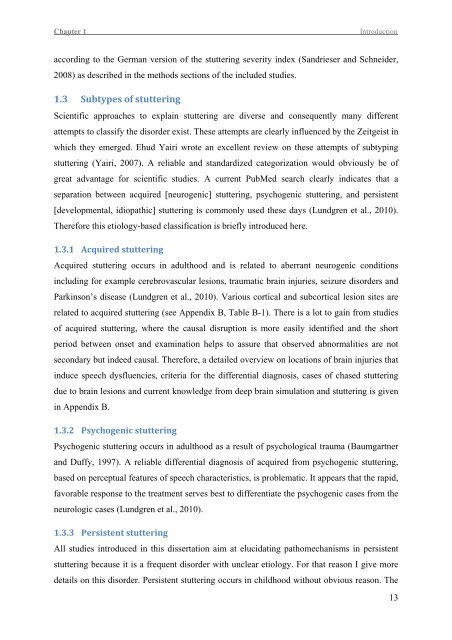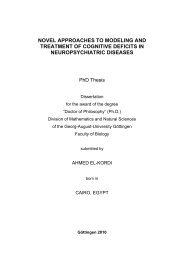Cortical and subcortical mechanisms in persistent stuttering ...
Cortical and subcortical mechanisms in persistent stuttering ...
Cortical and subcortical mechanisms in persistent stuttering ...
You also want an ePaper? Increase the reach of your titles
YUMPU automatically turns print PDFs into web optimized ePapers that Google loves.
Chapter 1 Introduction<br />
accord<strong>in</strong>g to the German version of the stutter<strong>in</strong>g severity <strong>in</strong>dex (S<strong>and</strong>rieser <strong>and</strong> Schneider,<br />
2008) as described <strong>in</strong> the methods sections of the <strong>in</strong>cluded studies.<br />
1.3 Subtypes of stutter<strong>in</strong>g<br />
Scientific approaches to expla<strong>in</strong> stutter<strong>in</strong>g are diverse <strong>and</strong> consequently many different<br />
attempts to classify the disorder exist. These attempts are clearly <strong>in</strong>fluenced by the Zeitgeist <strong>in</strong><br />
which they emerged. Ehud Yairi wrote an excellent review on these attempts of subtyp<strong>in</strong>g<br />
stutter<strong>in</strong>g (Yairi, 2007). A reliable <strong>and</strong> st<strong>and</strong>ardized categorization would obviously be of<br />
great advantage for scientific studies. A current PubMed search clearly <strong>in</strong>dicates that a<br />
separation between acquired [neurogenic] stutter<strong>in</strong>g, psychogenic stutter<strong>in</strong>g, <strong>and</strong> <strong>persistent</strong><br />
[developmental, idiopathic] stutter<strong>in</strong>g is commonly used these days (Lundgren et al., 2010).<br />
Therefore this etiology-based classification is briefly <strong>in</strong>troduced here.<br />
1.3.1 Acquired stutter<strong>in</strong>g<br />
Acquired stutter<strong>in</strong>g occurs <strong>in</strong> adulthood <strong>and</strong> is related to aberrant neurogenic conditions<br />
<strong>in</strong>clud<strong>in</strong>g for example cerebrovascular lesions, traumatic bra<strong>in</strong> <strong>in</strong>juries, seizure disorders <strong>and</strong><br />
Park<strong>in</strong>son’s disease (Lundgren et al., 2010). Various cortical <strong>and</strong> <strong>subcortical</strong> lesion sites are<br />
related to acquired stutter<strong>in</strong>g (see Appendix B, Table B-1). There is a lot to ga<strong>in</strong> from studies<br />
of acquired stutter<strong>in</strong>g, where the causal disruption is more easily identified <strong>and</strong> the short<br />
period between onset <strong>and</strong> exam<strong>in</strong>ation helps to assure that observed abnormalities are not<br />
secondary but <strong>in</strong>deed causal. Therefore, a detailed overview on locations of bra<strong>in</strong> <strong>in</strong>juries that<br />
<strong>in</strong>duce speech dysfluencies, criteria for the differential diagnosis, cases of chased stutter<strong>in</strong>g<br />
due to bra<strong>in</strong> lesions <strong>and</strong> current knowledge from deep bra<strong>in</strong> simulation <strong>and</strong> stutter<strong>in</strong>g is given<br />
<strong>in</strong> Appendix B.<br />
1.3.2 Psychogenic stutter<strong>in</strong>g<br />
Psychogenic stutter<strong>in</strong>g occurs <strong>in</strong> adulthood as a result of psychological trauma (Baumgartner<br />
<strong>and</strong> Duffy, 1997). A reliable differential diagnosis of acquired from psychogenic stutter<strong>in</strong>g,<br />
based on perceptual features of speech characteristics, is problematic. It appears that the rapid,<br />
favorable response to the treatment serves best to differentiate the psychogenic cases from the<br />
neurologic cases (Lundgren et al., 2010).<br />
1.3.3 Persistent stutter<strong>in</strong>g<br />
All studies <strong>in</strong>troduced <strong>in</strong> this dissertation aim at elucidat<strong>in</strong>g patho<strong>mechanisms</strong> <strong>in</strong> <strong>persistent</strong><br />
stutter<strong>in</strong>g because it is a frequent disorder with unclear etiology. For that reason I give more<br />
details on this disorder. Persistent stutter<strong>in</strong>g occurs <strong>in</strong> childhood without obvious reason. The<br />
13



